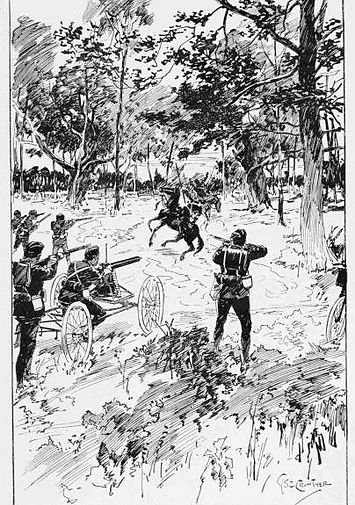top of page
Invasion of Heald Green in 1897!
By Richard Fletcher

First Published 17/6/2021
Last Updated 14/1/2022
A bizarre fictional account of war taking place in Heald Green and surrounding areas
Towards the end of the 19th century, a type of fiction became popular describing invasions of England by foreign powers. The political situation in Europe was very unstable at the time, and the authors of these books wanted to encourage the military authorities to be better prepared for potential attacks. One such author was William Le Queux, who in 1894 published an extraordinary book called The Great War in England in 1897.
Fig. 1 The book cover. Written by William le Queux, illustrations by Captain Cyril Field and T S C Crowther.
© Tower Publishing Company of London
Click On Image To View
The book describes a joint invasion by French and Russian forces, who land at Eastbourne and Hull and work their way across the country, destroying everything before them. At one point they reach Cheshire, and the following disturbing passage recounts what happens when they reach Heald Green:
“The enemy must have detrained a large number of troops at Wilmslow, for the British cavalry scouts were quickly followed up by Cossacks and the Tsar's Dragoons. Quickly the sentries between Heald Green and Appletree were driven back on their piquets, the latter extending in skirmishing order. Such a manœuvre, however, proved fatal in the darkness and on the heavy ploughed land over which they were fighting. Alas! very few succeeded in reaching the supports, and when they did, they all fell back hurriedly on the reserves at Pimgate…
Then the commander of the piquet at Cheadle Hulme Station, finding that he must inevitably be attacked by road and rail, set the station on fire, and with the assistance of the railway officials blew up a large portion of the permanent way with dynamite, thus cutting off the enemy's means of communication.
The Cossacks and Dragoons that followed the British cavalry scouts overtook them just as they had joined their reserves, a short distance beyond Pimgate, about half-past two. A fierce fight ensued, and the force of British cavalry and infantry was gradually drawn into a cunningly-devised trap, and then there suddenly appeared a great force of Russians, who simply swept down upon them, slaughtering the whole of them with brutal ferocity, not, however, before they had fought desperately, and inflicted enormous loss upon the enemy.
Having totally annihilated that detachment of defenders, the Russians marched into Cheadle, and, after sacking the little town, burned it, together with the Grange, the Print Works, the railway station, St. Mary's Church, and a number of large mills.”
Piquet is a military term for a small unit of soldiers positioned to give warning of an enemy advance. Appletree was the name of a farm situated between Etchells Road and Bradshaw Hall Lane. Pimgate, usually spelt Pym Gate, was the name of a farm along Styal Road to the north of Brown Lane. The Grange in Cheadle was a large house opposite the eastern end of Broadway.
The enemy forces then advanced towards Manchester, crossing the Mersey near Parrs Wood, but were repulsed by a stronger defence.
There were many other battles up and down the country, but eventually the English, aided surprisingly by German troops, triumphed. It is ironic that when war eventually came in 1914, it was the Germans who were the aggressors and the French and Russians the allies.
The full text of the book is available online here.
Fig. 2 1Illustration with the caption: “Gallant stand by cyclists in Parrs Wood”.
© Tower Publishing Company of London
Click On Image To View
Bibliography
-
Le Queux, W (1894). The Great War In England 1897. : Tower Publishing Company of London
Related Links
Search Our Museum Library (Google Drive account users only)
Timeline
Can You Help Us Improve The Museum?
-
Do you have any related personal memories, photos or documents that you can share with us on this topic?
-
Are any of our facts incorrect?
-
Contact us at healdgreenheritage@gmail.com, or via our Heald Green Heritage Facebook Page.
bottom of page




